
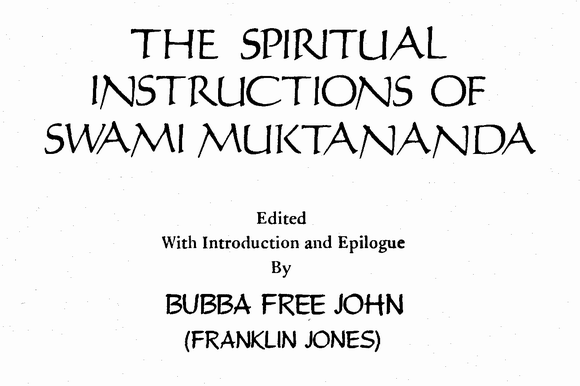

Copyright © 1974
by
Franklin Albert Jones
All rights reserved. No part of this book may be used or reproduced in any manner without written permission except in the case of brief quotations embodied in critical articles and reviews. The first edition published April, 1974.
The Dawn Horse Press
P. O. Box 677
Lower Lake, California 95457
First Edition
International Standard Book Number
0-913922-02-1
Library of Congress Catalog Card Number: 73-86295
Printed in the United States of America
We gratefully acknowledge Shree Gurudev Ashram, Ganeshpuri, India, for permission to reprint the photographs of Swami Muktananda and Swami Nityananda which appear in this publication.

CONTENTS
Introduction
The Spiritual Instructions of Swami Muktananda
Epilogue
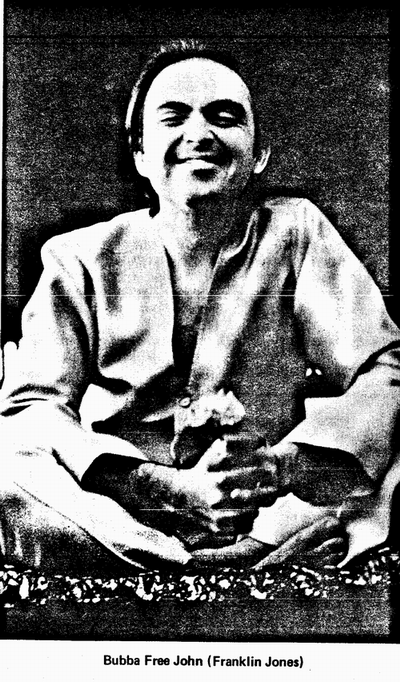
Bubba Free John (Franklin Jones) is an American Spiritual Master whose special “Siddhi” or Spiritual Function was matured in the company of Swami Muktananda and Swami Rudrananda (Rudi), as well as through the spiritual agency of Bhagavan Nityananda, Sai Baba of Shirdi, Sri Ramakrishna, and Sri Ramana Maharshi. His autobiographical description of this process and a summation of his teaching may be found in The Knee of Listening and The Method of the Siddhas (both published by The Dawn Horse Press) as well as forthcoming works. He resides at “Persimmon,” his Ashram in northern California.
Swami Muktananda (see Introduction) will be travelling to the United States and other parts of the world outside of India early in 1974. He usually resides at Shree Gurudev Ashram, located in Ganeshpuri, India.
Introduction
by Bubba Free John (Franklin Jones)
During the first week of April, 1968, I spent four days at the Ashram1 of Swami Muktananda Baba in Ganeshpuri, India. Thus began one of the most significant relationships in the whole affair of my spiritual life and experience.
“Baba” was born May 16, 1908, at Dharmasthala, South India. He adopted the career of a spiritual seeker, and spent his life wandering throughout India, studying the ancient traditions and practices of his country. He enjoyed the company of many great saints. But the consummate event in his life occurred in the mid-1940’s. It was then that he came to Ganeshpuri and received spiritual initiation from Bhagavan Nityananda, a great Master-Yogi. After this initiation, or transmission of the Divine Power, Baba underwent a spontaneous process of internal yoga, culminating in a perpetual Vision of the Divine. He has described this process in his book entitled Chitshakti Vilas, the Play of Consciousness.2
I was also such a wanderer. After some years of spiritual practice I in turn came to Muktananda. And the same spiritual initiation was activated in his presence. The peculiar manner in which this initiation matured in me is described in the autobiographical portions of my book, The Knee of Listening. 3
The present book is prompted by gratitude to Muktananda and Nityananda, to all of the eternal Spiritual Masters, and to the Great Lord who is Present as God, Guru and Self. It is an attempt to increase knowledge, particularly in the West, of the great and ancient spiritual process which is activated through intimate contact and surrender to a true Guru or Spiritual Master.
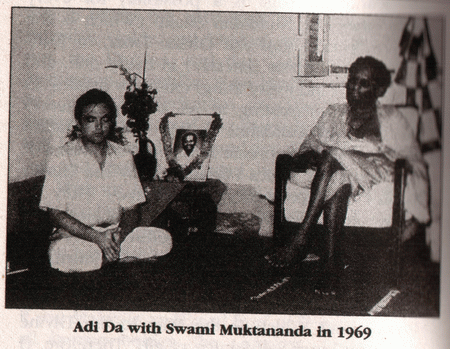
The main text is a letter I received from Baba after my initial visit to his Ashram in 1968. I had written to him some two weeks previous, on April 10, 1968, after my return to New York from my visit with him in India. Since it provides a convenient background for Baba’s letter of instruction, I give my own letter here, as it was written, except for a few preliminary and personal remarks:
Dear Baba,
Even now as I write, my eyes are wet and I long to sit with you. As you told me one day last week, “Now I have got you.” You have swiftly changed my life by directing me to the truth and the goal. Please do not leave me alone, now that I am far away. You have given me the seed, but I am a garden that needs much tending. I am still begging for the Shakti4 and right understanding so that I will not be overcome by my own ignorance and despair.
You have told me about the value of asanas,5 regularity of life, discrimination in diet and all other habits, and, above all, you told me to maintain myself in the truth
Vedanta:6 “Identify yourself with him who is the witness to the sleeping, waking, and dreaming states.” When I asked you how I should do this meditation, you said, “Do nothing.” All of these suggestions had an effect on me. After two days of trying merely to be relaxed in your presence I realized that I could not “do nothing,” and the truth of Vedanta6 and everything else you told me seemed too dry and distant and unavailable to me. On the third day, in the morning, as soon as I sat down before you for the morning recitation, I began to work inside at surrender, and all day that day my head and back moved violently. All during the day you encouraged these movements in me and called me “Kriyananda”7 all that day because of them. Twice you placed your hand on me. The first time I responded by closing my eyes, twisting about, and raising my hands into mudras. The second time, in the meditation, I fell backwards away from you. At the end of that day I was exhausted from so much kriya. On the fourth and final day, after the noon meal, I went to my room to pack. I thought I would rest for just a few minutes, since I felt my last few hours at the Ashram were precious time. But as I lay down I became very weary and felt a need to sleep. I felt myself going into a deep trance-like state in which somehow I was blissfully conscious. Then suddenly I became aware of my body. A sudden breath or snore came through my throat, and I realized I was experiencing a consciousness of my body that was completely detached and free.9 Just then Ninal10 came into the room to rest. I continued to lie still and then fell asleep. Later we went down for the afternoon recitation. I felt sad to be leaving. You had not called me “Kriyananda” that last day. I had not yet understood the meaning of my afternoon “sleep,” but I somehow felt I had your parting message and blessing with me. I felt a certain calmness, and since there was little movement I assumed that “Kriyananda” was not a name you intended for me to keep.11 I felt you were really leading me to a place where there is no movement (kriyas) at all.
Then, as the day went on, I began to think about my experience. I began to see that my experience in the early afternoon was of the “witness,” the Self who is behind all the modifications of the mind. I saw then that all you had told me earlier in our visit was not mere logic and intellectual description. It was a living truth to be experienced consciously and in depth. And now that we have returned to New York I recognize this truth of the Vedanta to be the essential thing you sought to teach me. As I think about the Ashram I realize that you are the Guru who liberates his children by leading them to experience their identity with the Self.
This truth, even though my deep resistance makes it impossible for me to experience it very frequently with any depth, is and will be extremely liberating for me. It is the very basis of sadhana12 and its goal. And it makes it very clear just how I must manage myself in relation to my daily experience. This truth is my joy, and you, Baba, are my joy, because you are leading me to a full realization of this truth. Please bless me with gratitude and surrender so that the obstacles in me will be overcome.
Nina and I long to be with you again. We send our love to all of your children.
Your child,
Franklin Jones
1 – The Hindu form of spiritual community; the hermitage or dwelling place of a Spiritual Master.
2 – Published by Shree Gurudev Ashram, Ganeshpuri, India, 1972.
3 – Published by The Dawn Horse Press (formerly The Ashram), Los Angeles, California, 1972.
4 – Spiritual Force, the Power aspect of God, which is present, active and apparent everywhere as everything, but which also lies hidden within every human individual in the form of latent energy, the kundalini or “serpent power” at the base of the spine. When activated through the agency of the Guru or Spiritual Master this force spontaneously generates remarkable, self-purifying processes in life, body, mind and the whole range of being. The peculiar forms these activities take are essentially unique in every case, but if all cases were taken together they could be said to fall into a finite number of specific categories, corresponding to the classical “schools” or paths of yoga or spiritual experience and practice.
5 – Yogic postures, physical attitudes conducive to health, vitality, and concentration.
6 – The great system of Hindu spiritual philosophy, which has been interpreted differently through several historical traditions. Fundamentally, all agree: There is One Reality, and no thing apart from it.
7 – Literally, one who is blissful with movements. Spontaneous movements
(kriyas) of head, back, indeed, the whole psycho-physical mechanism, characterized my first experiences with Baba.
8 – Symbolic gestures made with hands, face, body, etc.
9 – somewhat more detailed description of this experience may be found in The Knee of Listening, pages 77-79.
10 – my wife, who accompanied me to Baba’s Ashram.
11 – In August, 1969, during a second trip to India, Baba gave me the name “Dhyanananda,” meaning “one whose bliss or happiness is in absolute surrender to the True Self or Very God.”
12 – Spiritual practice.
The letter which follows, entitled “The Spiritual Instructions of Swami Muktananda,” is Baba’s reply to my letter and his response to the remarkable experiences which formed the content of my first visit with him. It is essentially addressed to my question: “How should I do this meditation?” But it is a capsule and poetic description of the whole process, path and experience of yoga, particularly the “secret” and miraculous yoga of the perfect Master-Yogis of all traditions.
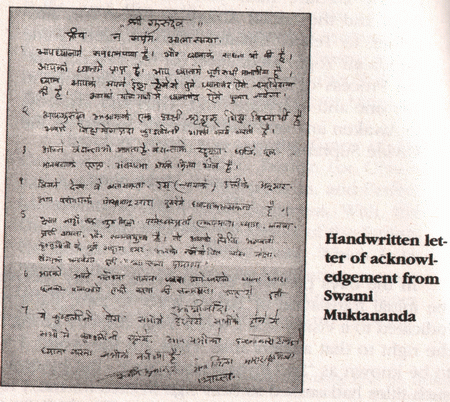
Dear Franklin,
My loving remembrance and blessing to you.
It is a matter of joy that you consider me as your Guru. You are inclined to Self-realization, you are devoted to Truth, you have practiced austerities to obtain the joy of Self. This is very good. Yours is a praiseworthy endeavor, because the Soul is an inner-treasure. It is perfect, It is One. This Soul is the Knower of all thoughts. It is Omniscient, yet It is neither a subject of logic nor can It be known through the intellect. Who can reveal That which reveals all? Who can bring to light the Sun which itself lights up the entire universe? The Soul is the Light, the Enlightener and the Enlightened. It reveals its own nature and reveals other things as well.
There is a divine Light within you which is as shining as the flame of a fire, as bright as the light of the Sun, as radiant as red-hot gold. The Soul is not a thing after which we should strive. It is ever present in us, but invisible to those who have not received the Guru’s grace. The Soul IS. Because of Its presence in the body, human beings love each other, they get mutually attached and feel satisfied through cordial relationship. The Soul which gives inner joy is in reality the Divine Light of God. The devout see Him in varied names, forms and colors. However, He is not many. He is One. Though He has many names, He is Soham.1 Although He belongs to the Hindus, Mohammedans, Christians and Parsis, He is different from all the religions, and, similarly, though belonging to the Yogis, He is different from the Yoga. Though grantor of the fruits of actions, He is different from the doer, though bestower of the reward of the sacrifice, He is different from the sacrificer, though understood through the Scriptures, He is different from the Scriptures. In the field of Knowledge, though realized through Knowledge, He is different from the Knower and the Known.
All the various creeds and faiths, all the religious organizations and societies the world over, worship Him, through their own set rules and disciplines. As a matter of fact, He is the all-adorable, the ever perfect, the inner essence, the Atman2 of all. Some people search Him in the sky above, some in the Earth below, some in the monastery, temple, mosque, or church, some others in the forest, in the seclusions, in the caves and mountains, in the rivers, lakes, streams, oceans and even dry deserts. Still others try to find Him in the sweetness of fruits, in the fragrance of flowers, in the song of the cuckoo bird, in the dance of the peacock, in the beauty of the butterfly, and so on. Thus, through various paths, in various things, everyone is searching Him only.
My dear Franklin! But He is within you. He, the Atman of all, is the Inner Being of both you and me. He is the darling pupil of the eye. That Atman is a clean place for our rest and respite, the strongest fortress for us to live fearlessly and peacefully, the liberator from bondage. That very essence is named by the Vedanta3 as Sat-chid-anand (Absolute Truth, Knowledge and Bliss). That very Atman or Essence is Ram and Rahim, Krishna and Karim, Jesus and Moses as well. He is the sole support of att. This universe is a manifestation of His infinite play. Putting on the twine forms of man and woman, He, the Great Being, exists in both. Truly, these are like the two faces of a single coin. They are named Purusha-Prakriti4 or Shiva-Shakti.5 And this world is the expansion of these two. He and He alone is in you and in your wife, and He again pervades the entire world. Usually an unfortunate one does not have the desire to know Him. But those who are greatly meritorious ardently wish to know Him, to know the Atman, and they succeed also.
Just as fire is latent in a dry stick of wood (which, when friction is applied, ignites and burns up completely), just as oil lies hidden in the sesame seed, just as there is butter in the cream, in the same way the Divine Shakti lies hidden in the human body. Ordinarily, It is active only in common ways. But when this same Divine Shakti is fully awakened through the Guru’s grace, we experience Its uncommon activities. To realize It directly is the highest religion of men. That which helps to manifest the inner Divine Shakti, is “True Religion,” and one who perceives that Divine Shakti in Its innate form, is “Truly Religious.”
This inner Shakti is also known as Atman, and is worshipped by uttering “Om”6 or “Soham.” Soham is the means for Its meditation. Soham is the mantrap for Its worship. Heart is Its church. The natural sound Soham does not belong to India and the Hindus alone. The same word-sound exists in all living beings, and it is active in all living beings. With regard to mantra7, truly speaking there is no consideration like community, creed, or country. If anyone thinks that a mantra belongs to a particular faith or country, believe me he knows nothing.
A great Yogini8 of Kashmir has said: “If a devotee believes the universe is the manifested form of God, and that He resides in all beings as their own selves, what place will not be a temple for him? Which mantra will not bear fruit?” In other words, any mantra that a true devotee would utter or recite will surely be fruitful, for mantra is, in truth, the form of God. When even a mere abuse or a mean word can affect a person mentally, how can a mantra, which is a holy word, not achieve its sacred purpose?
Dear Franklin, while sitting calm and steady repeat the mantra together with rhythmic breathing, prana and apana ,9 the rhythmic inhalation and exhalation of air or vital force. Harmonize the repetition of mantra with the breathing as follows: With “So” take it in, and with “ham” bring it out. Throughout the mantra-repetition one should follow this practice. Simply by sitting peacefully and applying the mind to the prana and apana one enters into a deep state of meditation. When one’s mind is fixed on “So” with the incoming breath and on “ham” with the outgoing breath, it is called mantra-japa. 10 The regulation of incoming and outgoing breath and vital force is called pranayama.11” If a person is skillful, intelligent and alert, the repetition of mantra, mantra-japa, the process of pranayama, and meditation, all three, can be achieved simultaneously and without difficulty. Such a one is like a kingfisher bird whose entire attention is fixed on a fish in water. This bird is known for its all-exclusive concentration, which is a kind of meditation. And when it suddenly dives to catch the fish, two more things are achieved simultaneously. He also has a good bath and enjoys a hearty meal!
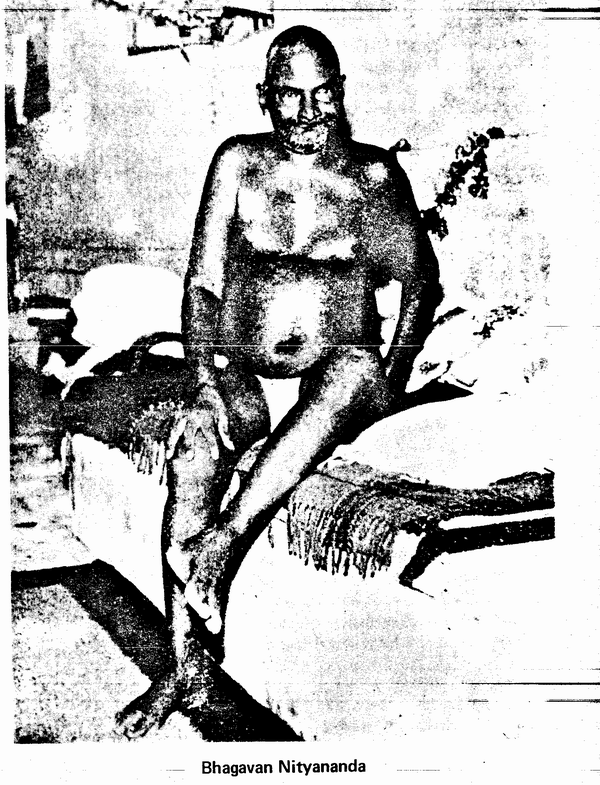
Ours is a great Yoga, the best among all. It is known as Siddhayoga, which means “the spiritual path of the Perfect Ones,” or “the Yoga which begets Perfection.” A skillful and intelligent person can practice it easily. The regular practice of meditation with a concentrated mind, as explained above, will awaken the dormant Kundalini Shakti12 in a very short time. As a result, many wonderful inner activities also begin to operate. Day by day, as the Shakti develops more and more, it takes the aspirant to the Ultimate Perfection. Just as a child grows daily, with due nourishment, and becomes a youth in course of time, just as a seed sown in the soil gradually develops into a tree, in the same manner the daily practice of sadhanal3 leads one to Perfection by the Guru’s grace.
In the Soham mantra, “So” (“He”) signifies God or Guru,14 and “ham” denotes “I” or “me.” “Soham” means “I am He.” Let your practice of meditation be accompanied by ceaseless reflection on the above meaning of Soham. In every human being there lies a hidden store of unlimited contentment, inexhaustible love, and infinite joy. These can be realized through the regular practice of meditation. As one thinks, so one becomes. If a man thinks all the time about his faults and sins, he will become sinful. Similarly, constant thought about woman, man, meditation or Guru will make him womanish, manly, meditative or the likeness of his Guru, depending on which of these qualities occupies him. This is quite natural, because a person always gets transformed into the likeness of the object on which he constantly ponders, by absorbing its qualities.
Man is indeed great by nature. But he has lost his greatness and fallen, due to his constant preoccupation with the external world and attachment to sense-objects. Internally, he is not lacking anything. He is already full and perfect with the Divine Light, and yet he vainly seeks for the “Fulfillment” outside. The factory, workshop, business office, market and store, or the varied professions, such as engineering, medicine, legal practice and many other trades, all these are merely a means of livelihood. They cannot procure things of lasting value to men. As I have said, man is perfect within, and this can be directly experienced through meditation. In meditation one feels fully contented. Just as in deep sleep you become entirely free of outside thoughts and anxieties and feel happy, similarly, in the introspective tendency or the meditation on Atman lie peace, respite and undisturbed equanimity.
True beauty, the essence of savory taste, the celestial music, the most soothing touch, and the sweetest fragrance all lie within. The yogis who have experienced such things within consider all outer things to be ordinary. When, as a result of loving devotion to one’s Guru and reception of his grace, the Kundalini15 is awakened through the practice of meditation, all the latent faculties are automatically activated and one attains perfection in due time.
Such a one also obtains the power of omniscience, which lies hidden in the heart. In what words can I express the beauty of inner Light! It is without parallel. All lights of the outer world are too dim and unpleasant before It. Similarly, compared to the inner celestial music our worldly music is crude and jarring. The relish of a drop of inner nectar is so wonderful that all the worldly savors put together are really nothing by comparison. This inner nectar is a divine ambrosia. The inner touch is too subtle and profound to be described, for it is a divine touch. Through meditation one attains this supreme ambrosia-of-love on which the inner shakti16 is nourished. It is a gift from the Guru obtained by the disciple through austerities.17
Dear Franklin, there is not anything in this world which cannot he achieved through meditation. In the practice of meditation, there is a highly miraculous and splendid Shakti which is beyond human comprehension. It is best to practice a natural meditation or dhyan.18 I will explain to you what meditation is, or how it is to be practiced: Sit quietly, calm and composed. If you like, sit in Padmasana,19 or any other comfortable posture. You may hold the eyes on a photograph,20 or you may keep your eyes closed. The condition and posture in which you can- be restful, mentally free from the objective world, and introspective, is the best asana21 for you. Don’t do anything. By this I mean you should remove the mind from its activities, arrest all kinds of desires, and surrender to whatever is spontaneously happening. Observe everything as a witness. That is the practice of “natural”22 meditation. It is the spontaneous meditation of the inner shakti. The meditation done by the inner shakti is the meditation created by the Guru’s grace. It is the real meditation of Soham. Indeed, it is the meditation of and by God. These are not different kinds of meditation, but I am describing one kind of meditation in several ways.
Tell me, if a man is not aware of this Shakti, or if he is not awakened to it, what is the purpose of this body of flesh? If this Shakti were riot already there, one would not have been attracted to this body made of flesh, bones, blood, muscles, skin, etc. Activator of the breathing process, Inspirer of the intellect, Contemplator of the mind, these are all functions of the inner Shakti, the inner Consciousness. The only worthy purpose of this otherwise impure physical body is to dedicate it whole-heartedly to seek the Inner Being.
Your beauty, your energy, your duty, your religion, your Guru and guide, your study, worship and prayer all lie in engaging yourself to the remembrance and repetition of “Soham,” “Soham.” This is my instruction, this is my precept. This should always be practiced and reflected upon. The deeper you go in meditation, the more of the divine experiences you will attain. Therefore, seek your inner Self, and you will have the fulfillment you cherish.
April 23, 1968
With blessings,
Yours
Swami Muktananda
Ganeshpuri India
1 – “I-am-He,” who is Very Consciousness, Conscious and Perfect Knowledge.
2 – The inner or very Self of all beings. Seen in itself it is the soul. Seen in Truth it is not other than Very Reality or Real-God.
3 – The Hindu system of spiritual philosophy wherein all existence is comprehended under the principle of One Reality.
4 – Conscious Being and Creative Energy.
5 – Formless Eternal Being and Divine Conscious Energy.
6 – A sound-symbol for the Eternal Reality.
7 – Sacred words with transformative power.
8 – Female practitioner of yoga. Yoga is a general term for the ways of consciously functioning in union with the Divine. A male practitioner of yoga is commonly called a yogi or a yogin. The word and its variants may be capitalized when used as a title or to indicate special adeptship or the Perfect Attainment.
9 – Prana and apana are the indrawing and outdrawing of vital force with the — breath.
10 – Repetition of mantra.
11 – Control of vital force through control of breath.
12 – The Serpent Power, the creative force of the universe, which also lies coiled or latent at the base of the spine in man.
13 – Disciplined spiritual practice.
14 – An adept Spiritual Master who manifests the function of God.
15 – Abbreviated form of the term Kundalini Shakti.
16 – Spiritual Force. When capitalized the term refers to the Universal or Perfect Divine Power. When written in lower case letters the term refers to that same Power in the form of various energies and activities, high or low, within the individual. The latter may also be signified by the Universal term.
17 – Self-control, spiritual discipline and spiritual practice.
18 – Divan commonly means meditation, the unbroken flow of attention to a single object, even the Divine Object. Thus, it signifies the means of conscious realization. But the term is also used to signify the attainment itself, which is intuitive knowledge of Perfect Oneness with God, Guru, and Self, the prior and Eternal Condition.
19 – The well-known “lotus posture,” the cross-legged pose of the yogis,
20 – A likeness of the Guru.
21 – Meditative posture.
22 – The Sanskrit term translated here as “natural” is sahaja, which means innate, spontaneous, self-generated rather than externally motivated. “Natural meditation” is the spontaneous meditation of the inner shakti.
EPILOGUE
You should not imagine that the Soham mantra which Baba recommends here is a mere gathering of verbal sound-symbols to be mechanically and hypnotically repeated. The teaching regarding this mantra is simply a form of instruction, a verbal instrument or sign through which the Guru conveys the way of the Spiritual Force into which he has initiated his disciple. Without such initiation, the mere repetition of a mantra is useless, except perhaps as a way to temporarily calm the mind.
Also, even one who performs this mantra according to the instructions of his Guru does not merely repeat syllables in his mind. Baba has written elsewhere: “He who is latent in all beings is your inner Self, the Supreme Lord. Worship Him with the feeling of Soham, that is, “I am He.” 1 Thus, meditation in this form is to be conducted with the feeling or sense of Soham, or the quality of prior identification with the Supreme Being, who is God, Guru, and Self of all. This feeling or sense transcends and transforms the repetition of mere words or concepts.
Baba’s spiritual philosophy is often given in the form of a capsule formula: “Kneel to your own Self. Honor and worship your own Being. Chant the mantra always going on within you. Meditate on your own Self. God dwells within you as you.”2 This is also the summation of his written advice to Bubba Free John (Franklin Jones). It is the way of realizing That which cannot truly be sought. And such advice cannot be separated from the initiation granted by God through the Guru. Therefore, if we are capable of receiving the words of the Guru, we should also remember always to turn to the source of those words, to the Guru himself, so that we never separate ourselves from the Divine Grace which is present as the Guru.
The Soham mantra and the grace of the Guru are inseparable. But when they come together in a natural and spontaneous manner, they represent the ancient awakening of True Knowledge. Recently, Baba has described this “event” as follows:3
On receiving grace, a seeker should sit firmly in a meditative posture. he should focus his mind on his navel, heart, ajna chakra4 or sahasrar.5 He should merge all his senses into the one Self and become completely absorbed in it. He should meditate on Siva,6 seeing the same One in all different thoughts and objects, and lose himself in the meditation. Thus he will realize Brahman.7
May All beings come to know and live in Truth.
Bubba Free John
(Franklin Jones)
May 31, 1973
Los Angeles
1 – Adesh by Swami Muktananda Paramahansa, published by Shree Gurudev Ashram, Ganeshpuri, India, 1963.
2 – Quoted from the jacket material, rear cover, of Chitshakti Vilas, published by Shree Gurudev Ashram, Ganeshpuri, India, 1972.
3 – “Bubba’s Commentairies,” on shivasutras 2/5 printed in Shee Gurudev Ashram Newsletter, volume 2, number 5, May 1, 1973
4 – The yogic center of concentration between and behind the eyebrows, often call the set of the Guru.
5 – The supreme yogic center located at the crown of the heard. The “thousand-petelled lotus.”
6 – The Formless Eternal Being, the Real and Perfect Nature of the Self or Atman, the Trugh of which the soul is a reflection.
7 – The Absolute, All-pervasive, Unqualified Reality that is also Present as all beings, worlds and things.
